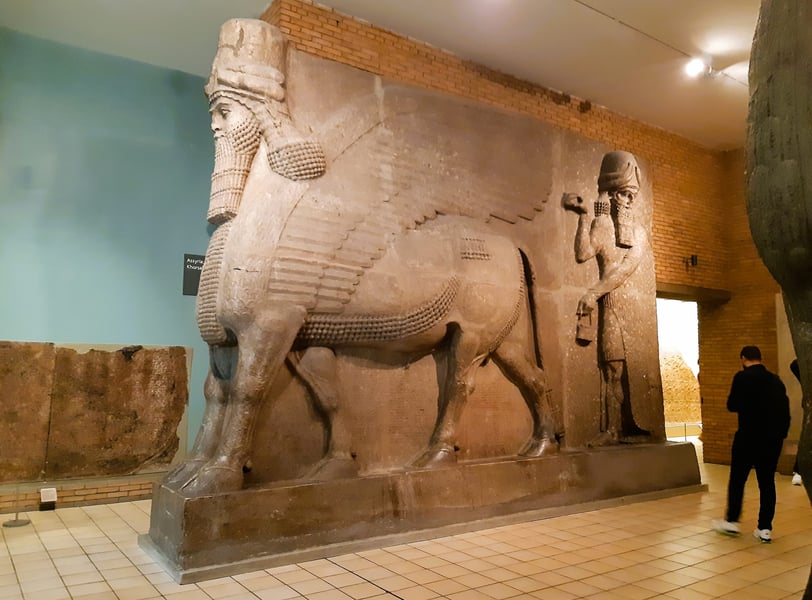Unlocking Ancient Worlds: A First-Timer's Guide to the British Museum
The British Museum is a treasure trove of human history, art, and culture. Home to over eight million artifacts spanning two million years, it’s one of the world’s greatest museums—and the best part? It’s free to visit.


So, you're finally in London, a city steeped in history and brimming with iconic landmarks. But amidst the palaces, the Tower Bridge, and the ever-present red buses, there's a treasure trove beckoning: the British Museum.
Don't be intimidated by its imposing facade; this guide will equip you to navigate its wonders and unlock the secrets of civilisations past.
A Chronicle of Cultures:
The British Museum isn't just a museum; it's a portal to the past. Founded in 1753, it houses a staggering collection of human history, art, and culture from across the globe. Think of it as a time machine allowing you to hop between continents and eras, all under one grand roof.
From the Rosetta Stone, the key to deciphering hieroglyphics, to the Elgin Marbles, remnants of the Parthenon, to the hauntingly beautiful sculptures of Easter Island, the museum's collection is simply breathtaking in its breadth and significance.
You'll find artefacts from ancient Egypt, Greece, Rome, Mesopotamia, Africa, Asia, and the Americas – a testament to human ingenuity and creativity across millennia.
Must-See Treasures for the Time-Crunched Tourist:
For first-time visitors, the sheer scale of the museum can be overwhelming.
Here's a suggested itinerary to maximise your experience and leave you feeling truly enriched:
The Rosetta Stone (Room 4): The Key to Unlocking Ancient Egypt: The undisputed star of the show and arguably the most famous object in the British Museum! Imagine a world where hieroglyphs were a complete mystery. This unassuming slab of granodiorite, inscribed with the same decree in three scripts (hieroglyphic, demotic, and Ancient Greek), held the key.
Its discovery and subsequent decipherment in the early 19th century opened up the entire world of ancient Egypt to modern understanding. Take your time to examine the different scripts, consider the significance of this linguistic breakthrough, and reflect on how it unlocked millennia of history. Be prepared for crowds – this is a popular spot!
Egyptian Mummies (Rooms 62-63): A Journey to the Afterlife: Step into the world of ancient Egyptian beliefs about death and the afterlife. This gallery displays a fascinating array of sarcophagi, coffins, and the mummified remains of individuals from various social strata. Marvel at the intricate decorations of the sarcophagi, adorned with spells and images intended to protect and guide the deceased on their journey. Consider the immense amount of time, effort, and resources dedicated to preparing bodies for eternity.
From elaborately painted inner coffins to the tools used in the mummification process, these objects provide a unique insight into the Egyptians' deep connection to the world beyond. Look out for the mummy of Katebet, a chantress of Amun from around 1300 BC, known for her exceptionally well-preserved painted cartonnage.
The Elgin Marbles (Room 18): A Glimpse into Classical Greece: This is a collection that often sparks debate, but its artistic merit is undeniable. These sculptures, also known as the Parthenon Sculptures, were originally part of the Parthenon temple in Athens, Greece. They depict scenes from Greek mythology, including the birth of Athena and the Panathenaic procession. Admire the incredible detail and dynamism of the sculptures, which capture the ideal human form with remarkable skill.
However, the controversial circumstances surrounding their removal from Greece in the early 19th century and the ongoing debate regarding their rightful ownership should also be considered. This gallery offers artistic appreciation and a chance to engage with complex historical and ethical questions.
The Sutton Hoo Ship Burial (Room 41): A Royal Grave and Anglo-Saxon Splendor: Journey back to 7th-century England and witness the incredible treasures discovered within a burial ship at Sutton Hoo. This remarkable find revealed the lavish burial of a wealthy Anglo-Saxon warrior or king. Gaze upon the intricately crafted helmet, the stunning gold jewellery, the silver tableware, and the other precious objects buried with him.
These artifacts provide invaluable insight into the sophisticated craftsmanship, social structures, and beliefs of early English society during the Dark Ages. Imagine the scene of the burial, the ship lowered into the earth, a fitting farewell to a powerful leader.
Assyrian Lion Hunt Reliefs (Room 10): Power, Majesty, and Ancient Warfare: These colossal stone reliefs, originating from the palaces of Assyrian kings in ancient Mesopotamia (modern-day Iraq), depict royal lion hunts. Lions were symbols of power and chaos, and the king's ability to hunt and kill them demonstrated his strength and authority. The carvings are incredibly detailed and dynamic, capturing the ferocity of the lions and the skill of the hunters.
Notice the expressive features of the animals and the meticulous rendering of clothing and armour. These reliefs offer a powerful glimpse into the art, politics, and warfare of the Assyrian empire, one of the dominant forces in the ancient Near East.
By delving into these specific details, the visitor gets a much better idea of what to expect and can tailor their visit to their interests. They also get a sense of the importance and wonder of these treasures, making them more likely to prioritize seeing them.
Navigating the Labyrinth: Tours and Resources:
Free Guided Tours: The British Museum offers free, introductory tours led by knowledgeable volunteers. These are a great way to get an overview and learn about key objects. Check the information desk upon arrival for schedules.
Audio Guides: For a more personalised experience, rent an audio guide for a small fee. These provide detailed commentary and allow you to explore at your own pace.
Download the App: The British Museum's free app is a treasure trove of information, with interactive maps, object highlights, and virtual tours. Download it before you go to plan your visit effectively.
Floor Plan: Grab a free floor plan upon entry. The museum is vast, and this will help you navigate and locate specific galleries.
Practical Information: Planning Your Visit:
Admission: The best part? General admission to the British Museum is free! However, some special exhibitions require ticket purchases, so check the website in advance.
Opening Hours: Typically open daily from 10:00 am to 5:00 pm (closing slightly later on Fridays). Check the official website for seasonal variations and special events.
Getting There: The British Museum is centrally located and easily accessible by public transport:
Underground: Tottenham Court Road (Central and Northern Lines), Holborn (Piccadilly and Central Lines), Russell Square (Piccadilly Line), Goodge Street (Northern Line).
Bus: Numerous bus routes stop near the museum. Consult Transport for London's website for specific routes.
Food and Drink: There are several cafes and restaurants within the museum offering a range of options from light snacks to full meals. However, these can be pricey, so consider bringing your own snacks and drinks if you're on a budget.
Accessibility: The British Museum is committed to accessibility, with ramps, lifts, and accessible toilets throughout the building. Wheelchairs are available for loan.
Tips for a Memorable Visit:
Plan Ahead: With so much to see, it's wise to plan your visit in advance. Choose a few key galleries or objects you want to focus on, rather than trying to see everything.
Wear Comfortable Shoes: You'll be doing a lot of walking!
Be Prepared for Crowds: The museum can get very busy, especially during peak season and weekends. Consider visiting during off-peak hours or later in the day.
Take Breaks: Don't try to cram everything into one visit. Allow yourself time to rest and recharge.
Respect the Artefacts: Remember that these are precious and irreplaceable objects. Do not touch or lean on displays.
Engage with the History: Read the labels, listen to the audio guides, and allow yourself to be transported to another time and place.
The British Museum is more than just a repository of artefacts; it's a gateway to understanding the rich tapestry of human history.
With a little planning and preparation, you can unlock its wonders and embark on an unforgettable journey through time.
